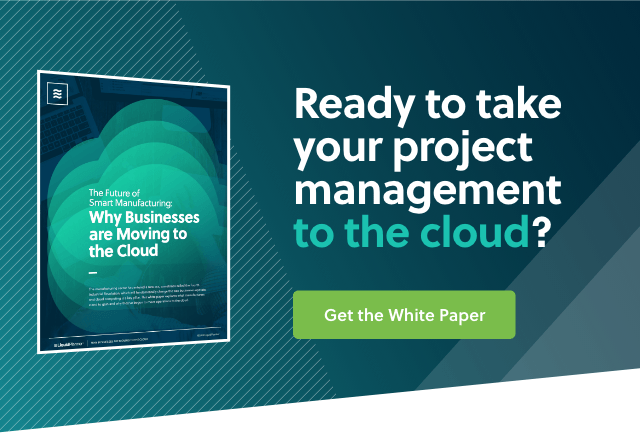Editor’s note: This is the second part of our series “Manufacturers and the Switch to Cloud-Based Software.” You can read the first part here.
As shown, manufacturers are moving to the cloud… finally. But that leaves the question of why they’re moving to the cloud, or rather, why now?
“It’s a bit like kicking a mule from behind,” says Jon Peddie Analyst Kathleen Maher (in a December 2017 interview). “Individuals and companies are slow to change and need a real push to get started—we saw that with PLM, BIM, and other new solutions. But as networks and tools are created and connections are made, it all starts moving quickly and new doors start to open.”
For many manufacturers, the ‘kicks’ come from government agencies. “Project lifecycle management is a good example,” Maher explains. “It really required a push from the government side to get started, but once it did all sorts of companies started to see advantages in all their operations—think about Tesla remotely collecting data from in-service vehicles, and even updating their product remotely. It’s been revolutionary.”
In manufacturing, a big push to the cloud is in response to a mundane challenge—paperwork. As manufacturing has become more distributed, involving global teams, simply tracking forms well is a major source of efficiency gains. “For many reasons—safety, performance, standards, regulatory requirements, you name it—governments and agencies are insisting on greater accountability,” says Maher. “That means a lot of paperwork, and anything that makes tracking and finding the right form or record more easily can be a huge advantage.”
She has a point; improved document control is often cited as a major reason for adopting cloud solutions. Not only are forms and reports tracked, all project-based communications—emails, texts, plans, photographs, etc.—can be collected in a single online space that is searchable and accessible to all stakeholders. Moreover, these documents can be maintained in formats that update automatically and avoid the version control issues that plague local software solutions.
Security is also improved, as security protocols can be applied at a single source, and document access is easily tracked. Especially with regards to project management, it’s easier to see what was done, what was not, who did it, and what’s left to do.
Deliberate, even reluctant, cloud adoption was a logical path for manufacturers, given the government and societal forces at work. But the bottom line is, it’s happened; early adopters in manufacturing and digital solution providers have worked together to create truly secure and powerful cloud platforms and services that are optimized for manufacturing.
Put another way, “new doors are open” and the road ahead is smooth. Moving to the cloud now is much easier for all manufacturers, even small and mid-sized firms. The Fourth Industrial Revolution (integrated, cloud-enabled manufacturing processes) is essentially complete.
So, it’s no longer the case that manufacturers are feeling forced (or kicked) into moving to the cloud. Instead, mature cloud networks and solutions are so powerful and useful that manufacturers are now racing to the cloud because they want to take advantage of amazing new opportunities…and not be left behind.
The Fourth Industrial Revolution
The idea of the Fourth Industrial Revolution sounds hyperbolic, but, “It’s absolutely true,” says Maher. “For decades now, leading thinkers in manufacturing have been working on and implementing a grand vision of factories and processes as digital—and cloud services are making that a reality.”
Maher suggests a couple of components of this “grand vision.”
Local, Custom Manufacturing:
If a manufacturer is sufficiently invested in the cloud, actual fabrication can be moved closer to the customers. “It doesn’t have to be your factory,” says Maher. “It can be the factory that’s best positioned to fulfill a particular customer’s exact needs.”
Even products like cars or refrigerators will eventually be realizable by distributed facilities, and customized for individuals. It’s a bit like the current state of print-on-demand books—assembled as needed, where needed, and customized.
Improved Collaboration & Project Insights:
Digital manufacturing more or less requires globally distributed teams of designers and specialized fabricators, which in turn requires collaboration tools that account for issues like time zone and language differences. Cloud solutions are well suited for global collaboration.
“This is one reason larger firms have led the way in moving to the cloud,” Maher points out. “When ideas are already being implemented by big teams, it’s easier to include outside talent in projects with transparency and control. Individuals at smaller firms, by contrast, tend to be more nervous about losing control of their ideas.”
Mature cloud solutions tend to mitigate this nervousness by improving collaboration. As discussed above, documents—and ideas—don’t get lost. Ideas are also conserved from project to project in single pools of knowledge.
One manufacturer, Lake Shore Cryotronics (makers of precise sensors and instruments for research applications), experienced this after moving to LiquidPlanner.
“Team members are using the commenting features in LiquidPlanner to communicate and provide task updates,” explains Development Process Manager Rob Welsh. “In the past, these project artifacts would have been buried in emails, with little in the way of organization or visibility. Now, comments are tied directly to the tasks and items they’re relevant to, in a way that provides visibility to everyone on the team.”
Continuous Design Lifecycle:
By remotely gathering data from the emerging Internet of Things (IoT) manufacturers can extend the design phase through production and even into end use by customers.
“We’re seeing this now with cars and industrial machines,” Maher points out. “By gathering data from machines in operation, manufacturers, operators, or service technicians can know, in real-time, if a car or machine is about to break down, and sometimes they can even fix it remotely. And of course they can use that data to improve quality of products being built.” The potential for greater quality of manufactured goods seems limitless.
But really, cloud platforms are changing manufacturing so quickly and profoundly that it’s hard to summarize the potential gains. As the 2017 report How Cloud Computing Enables Modern Manufacturing (Ezell & Swanson, June 2017, Information Technology & Innovation Foundation) says:
Cloud computing—the provision of infinitely scalable computing resources as a service over the Internet—is in the process of transforming virtually every facet of modern manufacturing. Whether it’s how manufacturing enterprises operate, how they integrate into supply chains, or how products are designed, fabricated, and used by customers, cloud computing is helping manufacturers innovate, reduce costs, and increase their competitiveness.
Critically, cloud computing allows manufacturers to use many forms of new production systems, from 3D printing and high-performance computing (HPC) to the Internet of Things (IoT) and industrial robots. Moreover, cloud computing democratizes access to and use of these technologies by small manufacturers.
That last bit is important; fully mature cloud infrastructure are now available to all manufacturers, in the same way that the fully paved national highway system is available to all drivers—the important thing is to get started.
But that doesn’t meant every manufacturer is going to take the same route onto the cloud. Ezell and Swanson say that, “Cloud computing is usually deployed in one of three different configurations: a private cloud, a public cloud, or a hybrid cloud.” And as Maher has analyzed cloud adoption by manufacturers, she’s learned that, “There are two different approaches. Some are centralizing all their data and their design and process tools. Others are moving their data to the cloud, but keeping tools local. Both approaches seem to work.”
It’s certainly the premise of this paper that any entry point works, so long as there is some movement to the cloud. In particular, starting with data-intensive processes, such as project management, is often the most efficient way to begin moving manufacturing processes to the cloud.
Ready to see how LiquidPlanner, a cloud-based project management solution, can help optimize your operation? Start a free trial today.








